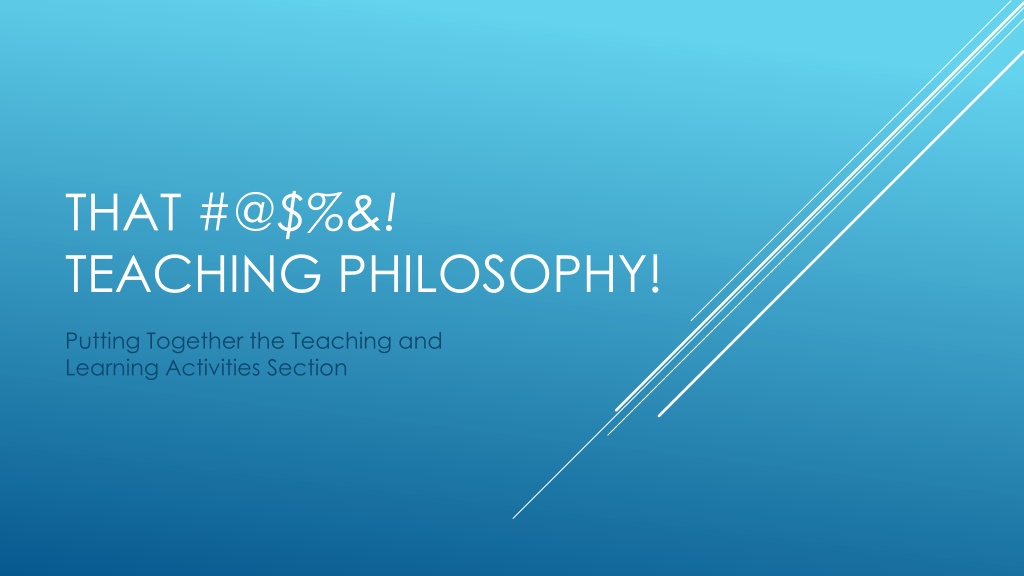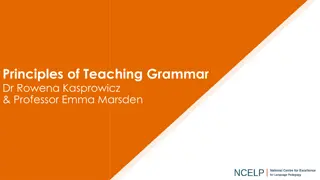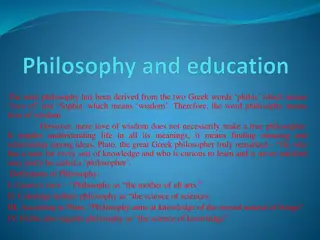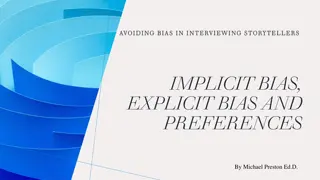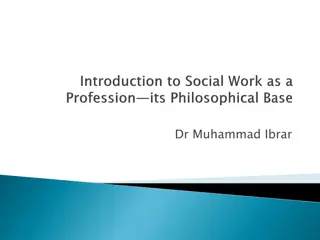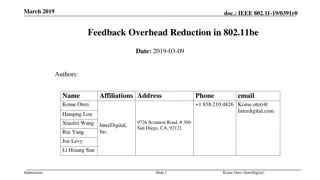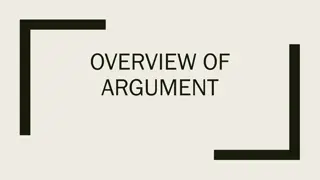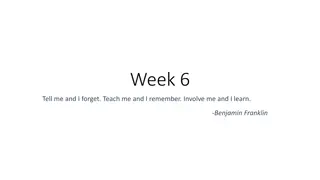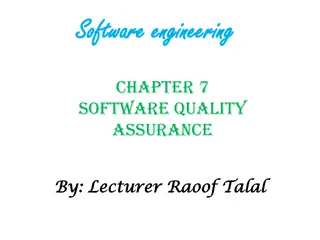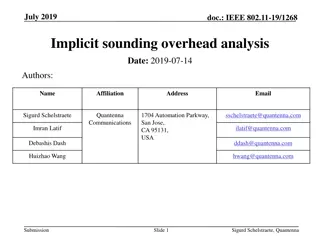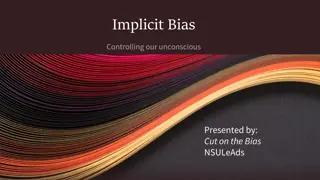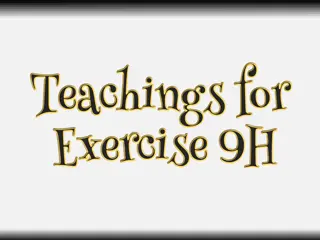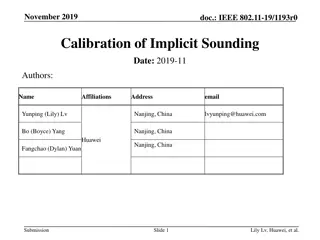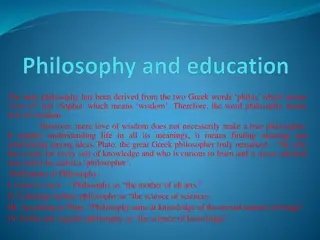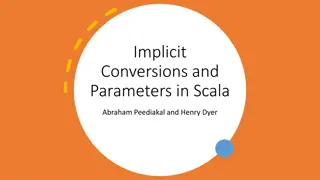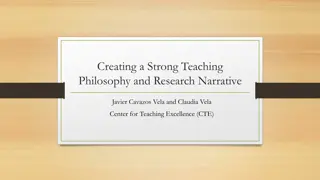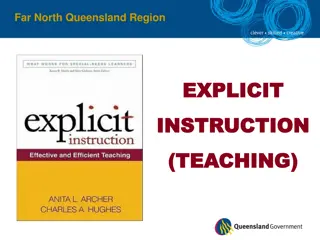Crafting Your Teaching Philosophy: Making the Implicit Explicit
Unveil the underlying principles of your teaching philosophy by exploring self-assessments, reading advice articles, and studying samples. Learn to articulate the core beliefs that guide your teaching approach and translate them into a compelling narrative for your professional portfolio.
Download Presentation

Please find below an Image/Link to download the presentation.
The content on the website is provided AS IS for your information and personal use only. It may not be sold, licensed, or shared on other websites without obtaining consent from the author. Download presentation by click this link. If you encounter any issues during the download, it is possible that the publisher has removed the file from their server.
E N D
Presentation Transcript
THAT #@$%&! TEACHING PHILOSOPHY! Putting Together the Teaching and Learning Activities Section
Yes, you actually do have a teaching philosophy! Goals and Objectives Cognitive Affective Behavioral Skills Ethics These tenets implicitly and explicitly guide you every day as you plan and deliver instruction.
How do you go about making the implicit explicit for the purpose of writing this section of the portfolio?
1. Figure out what your teaching philosophy really is. a. Read the section and Nuts and Bolts box in the Handbook, pages 14-15. b. Try out some self-assessments: https://tgi.its.uiowa.edu/ and Google Teaching Style Survey and Teaching Goals Inventory. c. Read some other advice: a. http://www.celt.iastate.edu/faculty/document-your-teaching/writing-a- teaching-philosophy-statement b. https://academics.lmu.edu/cte/about/archives/2013committeeontheco mprehensiveevaluationofteaching/teachingnarrative/ d. Look at samples: https://www.uky.edu/~drlane/teaching_philosophy.pdf and Google teaching philosophy samples
https://crlt.umich.edu/sites/default/files/resource_file s/CRLT_no23_revised.pdf
2. Write down the essential tenets of your philosophy. a. How many? Pick maybe four to ten it s your call. b. Organize them in some way. Do what makes sense. a. academic ones and affective ones? b. content vs. skills vs. attitudes? c. importance order? c. Decide how you re going to present them. a. philosophy first just discussing the theory and then a separate section of narrative with a discussion of the practice in each course? b. merge the two sections by discussing each tenet in theory and then giving examples of how you put it in practice in your class?
I. General Intro A. Value I A. Name it B. Explain it (what it is, its value) B. Value II A. Name it B. Explain it (what it is, its value) C. Value III A. Name it B. Explain it (what it is, its value) D. Value IV A. Name it B. Explain it (what it is, its value) Paragraph transitioning into discussion of specific courses A. Course 1 A. How Value 1 is demonstrated/assessed B. How Value II is demonstrated/assessed C. How Value III is demonstrated/assessed D. How Value IV is demonstrated/assessed B. Course 2 and so on . . . 3. Create an outline to keep your thoughts organized. Sample II.
Or this style: I. General Intro A. Value I A. Name it B. Explain it (what it is, its value) C. Give examples of how it is demonstrated/assessed in various courses you teach. B. Value II A. Name it B. Explain it (what it is, its value) C. Give examples of how it is demonstrated/assessed in various courses you teach. C. Value III A. Name it B. Explain it (what it is, its value) C. Give examples of how it is demonstrated/assessed in various courses you teach. D. Value IV and so on . . . Sample Or any style that makes sense to you and will make sense to your readers. II. Conclusion that summarizes/gives big picture
4. Fill in your outline. Make sure that you are giving examples of not only teaching activities, but also assessment activities and advising activities.
5. Type out a draft. Do you want a header before each section, or would you rather just have clear transitions/topic sentences on the front of each paragraph to let the reader know what you re doing?
Headers vs. Topic Sentences My philosophy of teaching has evolved over the years. As an instructor, . . . blah, blah, blah, blah, blah, blah, blah, blah, blah, blah, blah, blah, blah, blah, blah . Introduction As an instructor, . . . blah, blah, blah, blah, blah, blah, blah, blah, blah, blah, blah, blah, blah, blah, blah . One of the most important tenets of my philosophy is that graduates of our program must be lifelong learners. The field of XXXXX is always changing. There are new developments taking place every year, and in some cases, every few months. This is why . . . Goal 1: Creating lifelong learners The field of XXXXX is always changing. There are new developments taking place every year, and in some cases, every few months. This is why . . .
Tip: Dont be afraid to make overt references to your documentation. The documentation section contains an exercise from my ORD 2546 class that asks the students to research the answers to current questions in the field. The purpose of this assignment is to help students develop the skills necessary for discovering new techniques that are under development. After they graduate from the program, this will ensure . . . A letter of thanks from a former student serves as documentation of the time and care I take in advising students. I meet with them . . . The third page in the documentation section is a copy of the comments given to a student on the rough draft of his major project for ORD 1101. I write extensive end notes as well as in-text commentary in order to . . .
Tip: Explain any documentation that is irregular, the result of a group effort, or a revision of something created by another. The documentation is a project that is the result of a collaboration between Jane Doe and myself, which shows . . . Although this document has been used in the department for many years, I made significant changes . . . In the documentation is a copy of six PowerPoint slides that were originally created by XXXXX, but to which I have added . . .
6. Consider using a rubric to go over your draft. http://www.crlt.umich.edu/sites/default/files/resource_files/TeachingPhilosop hyRubric.pdf (from an outside source, but useful) CSCC P&T Handbook, Appendices O, P, or Q: https://www.cscc.edu/employee/faculty/teaching-professional- development/promotion-tenure.shtml
7. Get feedback from some outside readers. Your Peer Review Team Other faculty in the department Faculty outside your department
8. Revise and polish. Consider getting more feedback. Check grammar, spelling, and other mechanics. Make sure that the documentation is organized, paralleling the narrative.
Disclaimer: There are many, many ways to effectively present the Teaching Philosophy and narrative for the Teaching and Learning Activities section of the portfolio. This PowerPoint offers advice to those who would like guidance, but it is not intended to prescribe a specific format for all candidates. Candidates must use their own best judgment in applying any and all advice given.
